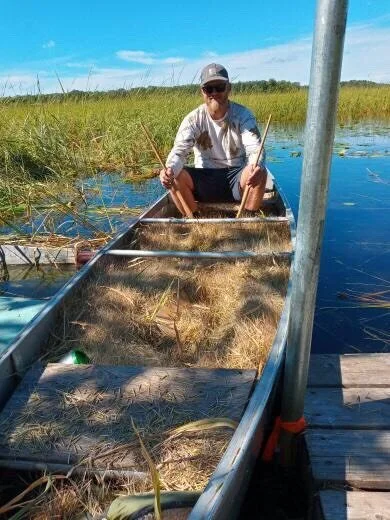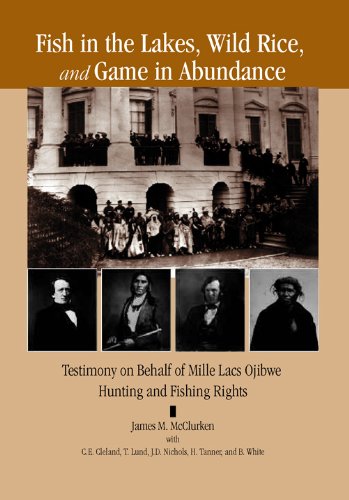I just got back from the most glorious week of harvesting wild rice that I have ever had. This is my 8th year harvesting wild rice, and each year I go out looking to harvest enough of this highly-nutritious grain so that we (my family of five) can eat it for the entire year, multiple times per week. If you know me at all, you know that I cannot stop talking about wild-rice harvesting. It is by far my most favorite thing to wild harvest. But harvesting rice can be a downright itchy, horrible, and muscle-aching event to partake in at times. So why do I look forward to it each and every year?
A gigantic boatload of rice. Rice worms infested my brain that day.
Let’s go back to my very first year harvesting rice. I met this older half-Anishinaabe man at a cider bar in downtown Traverse City, and after the evening talking over ciders, he invited me out to harvest rice with him later on that year. I was ecstatic. I could not believe my luck. Wild rice harvesting was at the very top of my bucket list of wild harvesting. This was not mere wild greens, no, this was harvesting staples.
Of course, all the little fairy tales that we tell ourselves about wild harvesting or hunting eventually vanish once we actually take part in these affairs. This older man took me out ricing and he spent a few days teaching me how to harvest wild rice. Ricing was definitely not an easy affair. The mere act of harvesting alone is hard work, and that is not even taking into consideration the transformation that occurs when the hulled things that you knock into your canoe become edible grains. That process, known as “dancing the rice” or “jigging the rice”, I did for 4 years. Now I just take it to a processor at the Bad River Indian Reservation and I pay him to do for me in a single weekend, what once took me 4 or 5 entire weekends a year.
Having now harvested rice for eight years, I now know that my original teacher may not have actually taught me how to harvest all that efficiently or even quickly. I look back at those early days of harvesting maybe ten pounds and I have to chuckle to myself a little bit. It is not uncommon for native harvesters in Minnesota to pull into the boat launch with 400 pounds of green rice in their canoes. I once felt pride in my measly ten pounds of rice! Of course we should all feel pride in those achievements that surpass previous goals. Seeing as how I had never harvested rice before, ten pounds was a good amount.
Those early days of rice harvesting were easy though. Going at a leisurely pace, probably missing 50 percent of the rice we went by, and not going in straight, neat lines through the rice. Fast forward to today, I am a few days removed from having harvested rice for 5 days straight in Minnesota with my great friend Gil Schwartz, where the pace was anything but leisurely, where we treat it as disrespectful to miss rice, and the breaks are few and far between. Harvesting the way we harvest is hard. There is no lunch break while harvesting in a state that only allows you to legally harvest between the hours of 9:00 am and 3:00 pm. You quickly shovel food into your face in five minute increments before getting back at it.
If you knock, then your arms are constantly in motion as you make your way through the rice. If you pole, then your whole body is engaged in what amounts to a challenging workout mixed together with an exercise in not tipping the canoe over. Gil and I switch roughly every hour or so. Before I harvested with Gil, I was almost never afforded the opportunity to knock, because most of my ricing partners were afraid to stand up in the canoe, so I ended up poling all day on 95% of my outings into the rice. After standing in a canoe for hours the bottoms of my feet start to tingle and feel numb. This is why having a partner that can both knock rice efficiently but also pole is a must.
Soreness of muscles and tingly feet is nothing however compared to the breathtaking amount of insect life that soon begins to inhabit your canoe as you make your way through the wild rice stands. In Michigan, there are thousands of tiny spiders usually all actively spinning webs in your canoe as you bury them in deeper and deeper levels of Manoomin. For a reason that I have yet to understand, the wild rice in Wisconsin and Minnesota seems to have less of these tiny spiders but massive amounts of rice worms. These worms do exist in Michigan, but they are not as plentiful where I have harvested. Last week, in Minnesota I saw thousands of these worms per day in our canoe. Thousands. They often crawl up your feet and ankles as you are poling, and you must try as hard as you can to just ignore them, because it is better to have worms on your ankles rather than a boatload of spilled rice.
Then there is the undeniable itchiness that accompanies you on your trips through rice stands. Wild rice barbs always find a way to penetrate your clothing and will try and stick to as much of it as it possibly can. Usually after a day of ricing, I find rice in my beard, my pants pockets, stuck to my shirts, stuck to my pants, and sometimes to my utter disbelief I even find it in my belly button! This sort of itchiness is something I have rarely seen ricers talk about, and it is probably the biggest reason I see native ricers wearing full-length pants and shoes despite the heat.
After having painted this picture for you, I suspect you are probably quite flabbergasted by my intense love of harvesting wild rice. I love wild rice because it is so hard, because it is such a pain in the ass to harvest. Despite these hardships, I manage to have a blast out on the water. I get the silence that you can only now find in some places in the world, I get to disconnect from antisocial media, I get to connect with friends and have deep, meaningful discussions about life and what the hell all of this means anyway. I often see all sorts of wildlife ranging from eagles to muskrats. All of these interactions are buried deep down into my psyche to be resurrected with every hard-earned meal that I eat.
It is precisely these difficulties that build character in all of us—they change us for the better. Life no longer becomes this sedentary spectator sport, but a real-life, hands-on event that produces tangible results. The wild rice that my family eats is not thrown into the garbage. Each and every bite is respected, honored, and treated with a reverence that one could never give to unearned food. Those of us that engage in difficult endeavors learn to seek out other difficult endeavors because we know that at the end of each, the reward is not only the food, but the deep-seated feeling of satisfaction that comes from overcoming the mind when it says to quit.
Wild-rice harvesting is just harvesting food to those that have not done it, but to those that have, it is much, much more. Over the last 8 years I have grown so much in my relationship towards hard work, and the changes that wild rice has made to my personality cannot be overstated. A simple once-a-year harvest has shown me the value of self determination and hard work. Along the way I have also gained an immense appreciation for challenges rather than an antipathy towards them. Don’t let this blog scare you! Do as my fiancée Madelyn of www.bloomwildcraft.com has done and face your fears (she hates spiders), by doing the thing that scares you most! I promise you that it will be worth it in the end
Thank you for reading this blog! If you are looking for a way to help support me in my writing and teaching endeavors but are lacking in funds then all you need to do is click through any of the amazon links on this website, like the one below, and you can do the shopping you normally do, but I will get a tiny percentage of the money you spend on amazon and it costs you nothing! Thanks again


